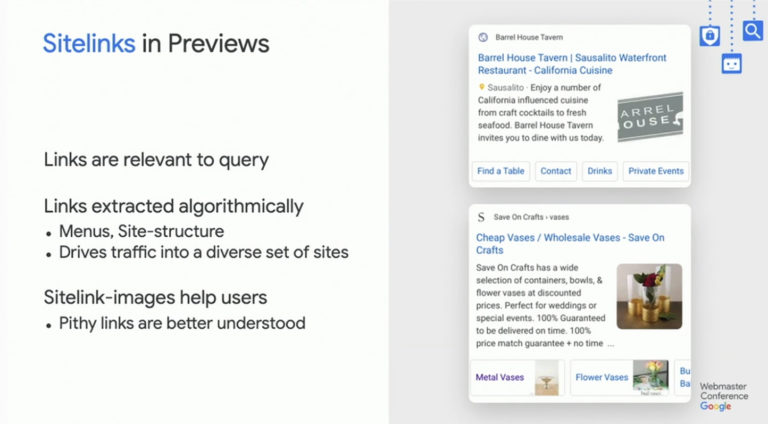Google explains the guiding principles behind search result previews that took the results page from 10 blue links to where we are today.
This was explained by Phiroze Parakh, software engineer at Google, at Google’s Webmaster Conference last November.
Google recently uploaded a batch of videos from the conference, so for most people this is their first time seeing it.
Here’s a recap of Parakh‘s presentation on titles, snippets, and result reviews.
The Four Pillars of Result Previews
The main task a user has after landing on a search result page is to find the content they need.
Result previews previews help them do that. Although they weren’t always as useful as they are now.
Previously, in the world of 10 blue links, all the information a user had to go on was a title, a snippet, and a URL.
In an effort to make result previews more helpful, Google came up with four “core pillars”.
- The primary goal is relevance to the user need, because previews need to be relevant to the query.
- Second goal is to make sure the preview helps users make a choice between which result to click on.
- A third goal is to illuminate the depth of content within websites
- The fourth goal/pillar is content diversity.

Reimagining Result Previews
When reimagining what a result preview should look like, all Google had to work with was the name of the site, the title of the page, and a content preview.

Google came up with different ways to algorithmically generate result previews based on the four pillars described in the section above.
Rewriting Snippets
First, Google started to change the snippet in response to the query.
The same algorithm that decides if a page is relevant to a query can be used to decide what part of the page should be relevant for the user.
That means, if the query was changed, the snippet displayed would also be different.

Google wanted to go beyond that, so here’s what it did next.
Images in Result Previews
Around 2016 or 2017, Google discovered that images helped users choose between different results.
This is especially true for certain types of queries where an image of whats being searched for can be extremely relevant – such as searches for a particular product.
Google started algorithmically extracting relevant images from pages and showing them in search results.

When this change was rolled out in search results, users started visiting a greater diversity of sites.
Videos in Result Previews
After the positive response to images in search result previews, the natural next step was to display videos.
Again, Google focuses on surfacing only the most relevant videos in result previews.
It was also noted that result previews with a video will render differently depending whether the video is a dominant or supportive piece of content.

Sitelinks in Result Previews
To achieve the goal of expressing the depth of content within sites, Google began incorporating sitelinks into result previews.
Sitelinks are links to pages within a site that Google believes are relevant for the individual user.

Like images and videos, sitelinks are all extracted algorithmically. Although the site structure does help with this.
Google took this a step further by adding images to sitelink previews.
Sitelink images were found to be helpful in cases where a plain sitelink doesn’t provide enough detail.
Entity Facts in Result Previews
Entity facts were added to result previews as another way of expressing the depth of content in a web page.

Forums as Previews
Google created special result previews for web forums that can be generated whether or not the forum is using structured data.
Google can algorithmically extract posts and generate a “cluster” of content that’s relevant to the user’s query.

Markup isn’t needed to generate these previews, though Google will utilize Q&A markup if it’s provided by the forum.
Tables & Lists as Previews
If a web page has a dominant table, Google can show at least some of the table in the search results preview.

Those are all the changes result previews covered in the presentation.
For more detail, see the full video below:


